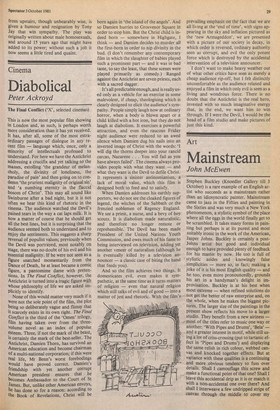Art
Mainstream
John McEwen
Stephen Buckley (Knoedler Gallery till 3 October) is a rare example of an English artist who succeeds as a mainstream rather than an idiosyncratic painter. Mainstream came to jazz in the Fifties and painting in the Sixties and was very much a New York phenomenon, a stylistic symbol of the place where all the eggs in the world finally get to be scrambled. It takes many forms in painting but perhaps is at its purest and most suitably ironic in the work of the American, Jasper Johns. Buckley is certainly a postJohns artist but good and individual enough to have provided plenty of feedback for his master by now. He too is full of stylistic asides and knowingly false simplicities — more so, in fact; making a joke of it is his most English quality — and he too, even more pronouncedly, grounds his art in a handyman's delight in improvisation. Buckley is at his best when most extreme — when refined solutions do not get the better of raw enterprise and, on the whole, when he makes the biggest pictures. The larger size of the paintings in the present show reflects his move to a larger studio. They benefit from a new airiness — most of the titles refer to music one way or another: 'With Pipes and Drums', 'Bela' — and a greater interest in motif, while still using a lot of criss-crossing (put to tartanic effect in 'Pipes and Drums') and displaying the same relish in rich colour, webbed canvas and knocked together effects. But at variance with these qualities is a continuing and more obvious tendency to fuss over details. Shall I camouflage this screw and make a functional point of that one? Shall I leave this accidental drip as it is or match it with a non-accidental one over there? And shall I interweave a few undripped strips of canvas through the middle to cover my tracks further? Whether Buckley agonised over the screws and drips of his recent work in this way is of secondary importance. The point is, they look as if he did. Technical niceties are the recourse of artists who have run out of ideas. Buckley, happily, is very much not in that position. This show is of a wider conception than either of his previous ones at Knoedler's and marks the emergence of a more reflective, less swashbuckling, approach. As long as reflection does not encourage further distraction the forecast is set fair.
One of the few highlights of Royal Academy Summer Exhibitions are the pencil drawings, usually of animals at the zoo, by Gertrude Hermes. This year she is 80 and to mark the occasion the Academy — of which, of course, she is a member — have honoured her with a small retrospective exhibition (Royal Academy, Diploma Galleries till 18 October). The artist's first grown-up ambition was to be a farmer, and her feelings seem most untrammelled, her style at its most beneficially simple, when depicting the countryside and/or animals. She is perhaps best-known as a wood engraver, and certainly such delicate and evocative examples as 'Through the Windscreen', in which car headlights bore into the darkness of a deserted summer night, are the greatest distinction of the show. When, however, it comes to sex and life, confusion enters to the cost of design. Feeling for line also leads her astray into sculpture, where her carved figures become lost in Leon Underwood and her bronze portrait busts only escape Epstein through the use of genteel mannerisms. Simplicity and emotional contact return with a glimpse of those seductively free and easy pencil drawings and some erotic copper-plate engravings, all the more charming and original for showing a feminine attitude to desire; but one is left, on the basis of Summer Show expectations, feeling cheated, though more by the selection than her.
The most amusing and long lasting of English art colonies has undoubtedly been that at St Ives in Cornwall. Karl Weschke, who is showing a selection of recent and not so recent paintings and drawings at Moira Kelly Fine Art (till 7 October), is perhaps the least famous of the post-Nicholson! Hepworth group of St Ives artists, who made their name in the Fifties. The paintings of his English contemporaries in Cornwall could have been done anywhere, but Weschke, being German, paints pictures that are charged with a feeling for the spirit of the place. Mythic horsemen out of Bocklin, a scapegoat out of Holman Hunt and other solitaries are set against the doom-laden, storm-laden, sallow, purple and iron-grey landscape of wild Cape Cornwall. Even his interiors have a burnt seafeeling about them, the anonymous but never clinically observed female nude profiled by a salt-white line. Animals and animal passion conveyed by movement are his forte, but with a stationary and weakly composed central figure, like the goat, the atmosphere still comes through.







































 Previous page
Previous page